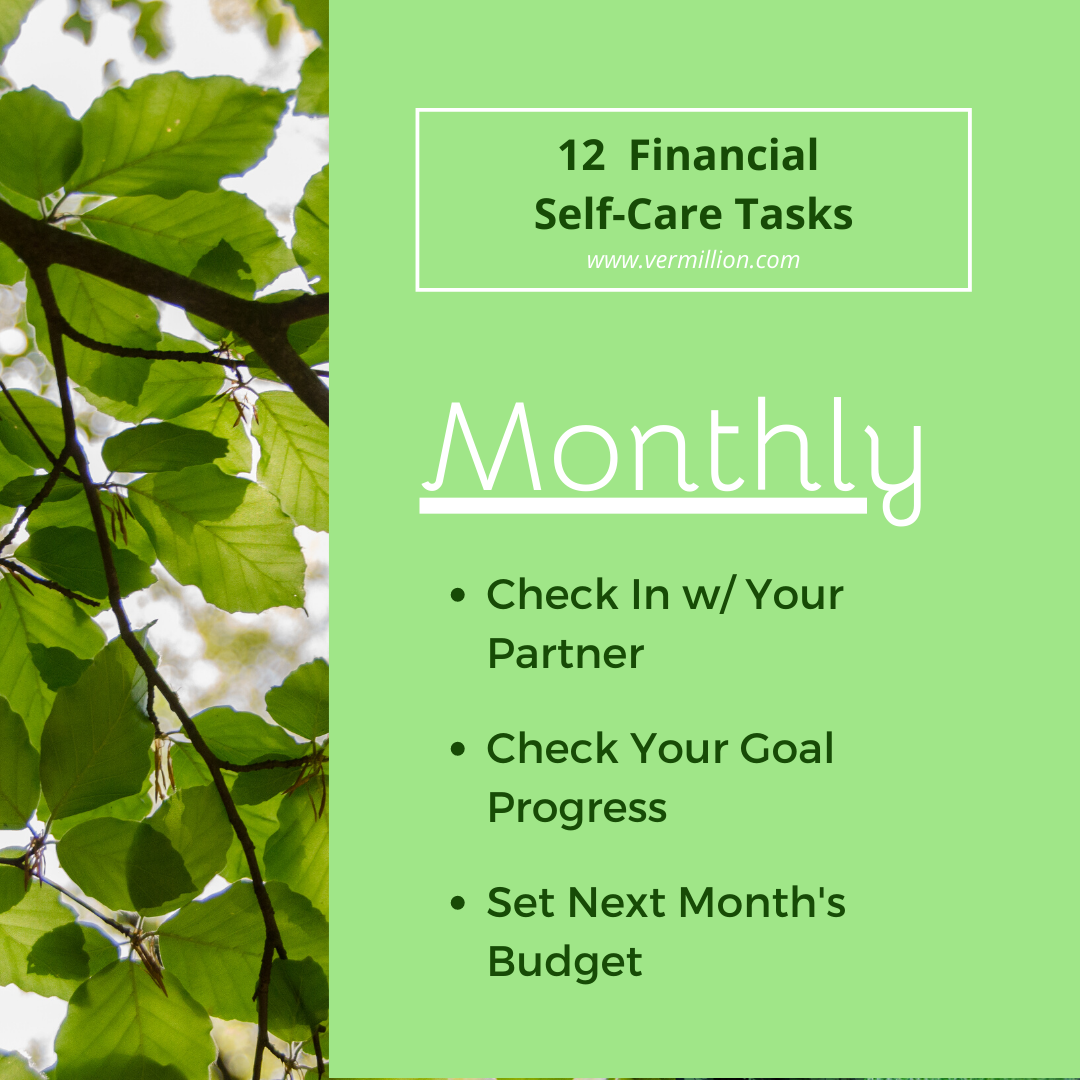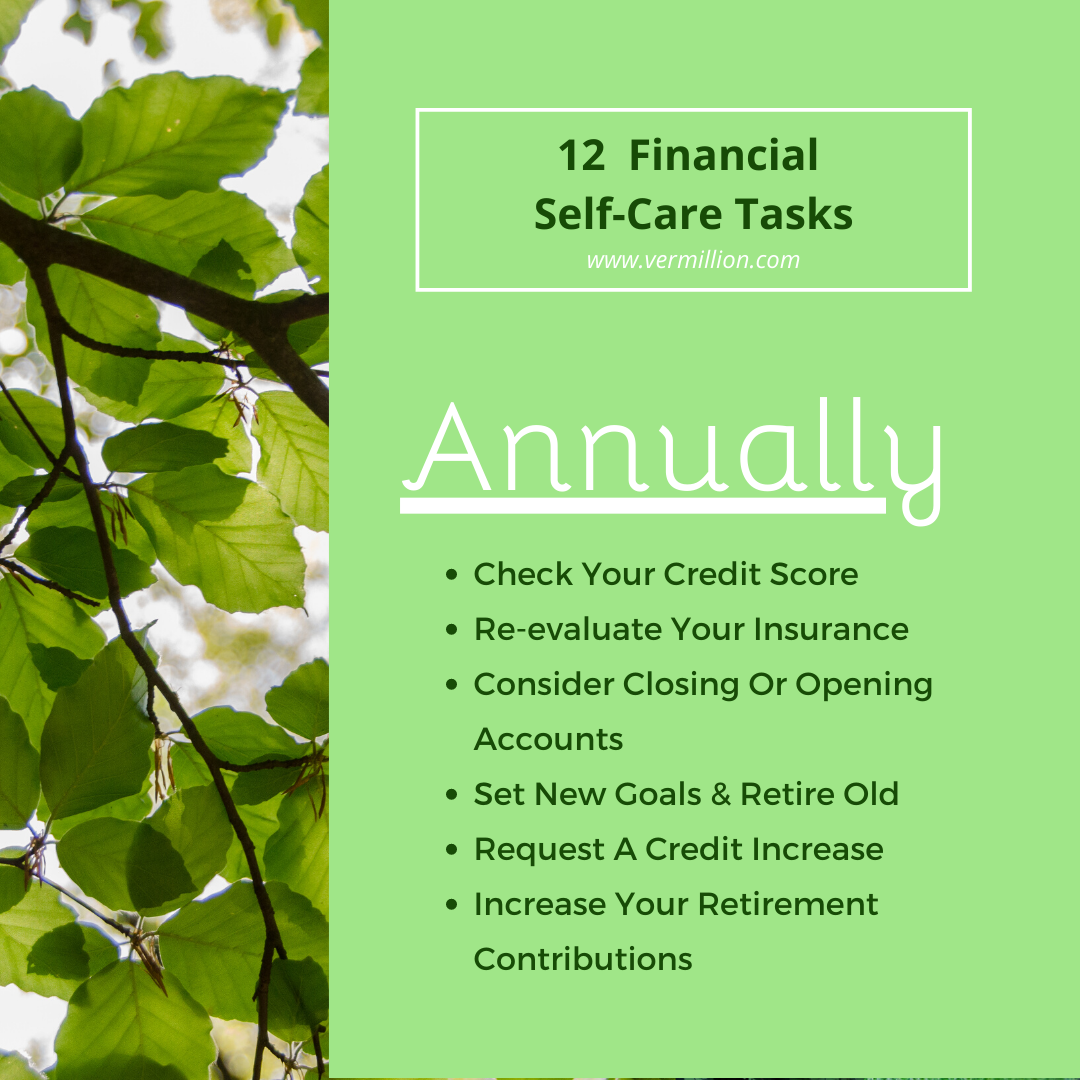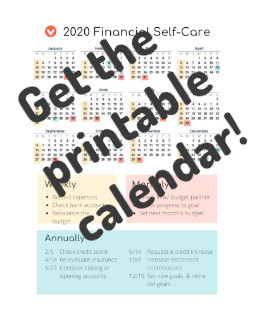13 Financial Self-Care Tasks


We’re fortunate to earn money when you click on links to products or services we already know and love. This helps support the blog and allows us to continue to release free content. Read our full disclosure here.
Winter can be incredibly stressful for folks already under a lot of financial stress. Between the holidays, family matters, and Seasonal Affective Disorder – any added pressure is a recipe for disaster.
Self-care is a concept that can be applied to many parts of your life – physical, mental, and even… financial! It’s all about taking time to ensure that you’re rested, recharged, and ready to continue on your journey without falling into a million pieces.
Finances become stressful, in part, because we ignore them. But with the right cadence of financial self-care you’ll find more bandwidth in your budget for the things you care about!
It’s not all about rewards, either.
Self-care should be a mindful, conscious undertaking to improve your situation. So while spending $50 on some new shoes might make you feel better – it doesn’t always promote long-term benefits.
Here are 12 self-care tasks that will!
Or skip straight to the printable calendar→
Weekly - Routine Maintenance
Just like a healthy meal, a good night’s sleep, or the occassional TV binge – it’s important to build in regular moments of care to our daily lives.
While I certainly enjoy ogling my budget balances daily, you’ll be all right if you check off these tasks at least once a week. Skip to calendar→
1. Record Expenses
Save yourself the stress of coming home to an unruly budget by recording expenses as they occur. You may want to be more rigorous if you’re new to budgeting by logging the expense as you’re in the checkout line or as soon as you get home.
If you’re a seasoned pro, you may be fine sitting down to record them once a week. The longer you go between updates, however, the more items you may have to add.
Look out for your future self and aim to update your budget frequently.
2. Check Bank Accounts
As you update your expenses, it helps to log into each bank account at least once to make sure you’re up-to-date on all of the transactions. This is also a great way to catch any suspicious activity or fees that you may need to alert your bank to!
Make sure to keep a sharp eye out for any scheduled expenses you may have forgotten about – especially if they’re put on a seldom-used credit card that you may forget to pay!
Logging in just to check the balance regularly can significantly reduce the anxiety around your money. The best remedy for fear is knowledge, followed by action.
3. Rebalance Your Budget
Ever have one of those months that goes completely right?
Every expense was perfectly planned, right down to the last cent.
…Me, either.
As you near the end of the month, make sure you’re adjusting your budget to account for any overspending. Just be careful not to overbudget!
It’s tempting to fund each budget category to the fullest, but if you don’t have money available – you’ll wind up overbudget. You can’t tell where the problem is – it’s the whole budget!
Overbudget or Overspending?
This will reinforce your motivation to save and help you estimate more accurately in the future. If you’re first starting out, this is a great weekly task. It’s completely normal (and encouraged!) to tweak your budget throughout the month to reflect where your money needs to go.
Make sure you do this at least once at the end of the month to cover any overspent categories and maximize your savings.
You may have heard people say, “Pay yourself first.” Well, I prefer to pay myself first, last, and in-between.
First, Last, And In-Between
Monthly - A Little Check-Up
We all know what we should be doing… so set aside time to actually do it!
Sometimes the hardest tasks to plan for are the ones that don’t need to happen every day, or even every week! Pick a day every month to knock out these tasks so you can take the looming stress out of the equation. Skip to calendar→
4. Check In With Your Partner
If you share an account with someone, you’ll want to be on the same page every step of the way. Sit down once a month (at least!) to compare notes and make sure you’re both on track.
If you need to make adjustments to a shared budget, make sure you’re both in the room. Good financial communication is vital to any partnership that has a financial component - whether that’s romantic, platonic, familial, or business!
Even if you don’t share an account with someone, it’s a good idea to check in with a friend you trust. You don’t need to tell them about every dollar, but do fill them in on how you’re doing.
5. Check Your Goal Progress
As you finish each month and move on to the next, take stock of your goals and how much progress you’ve made. This is a great time to reflect on your efforts and rethink your strategy:
- Did I do anything differently this month? (E.g. Bringing lunch to work.)
- Did it impact my behavior? (E.g. “I spent less on food.” Or “I spent more on groceries or buying dinner to compensate.”)
- Should I continue this strategy?
- Are there any new tactics I should try?
6. Set Next Month’s Budget
If you’re still living paycheck-to-paycheck, this one might be tough since you won’t have the money upfront to plan your next month. But if you’re operating one month ahead, you’ll want to take a few minutes to fund all of your accounts with the money you earned this month!
Being intentional with your money will keep you on track to meet your goals.
The process can be boiled down to three month-to-month steps: Start saving. Switch your source. Make new money “Available Next Month”.
How To Get One Month Ahead
Annually - The Full Physical
Some tasks are extremely important, but not necessarily time-sensitive. You should set aside time to check these off at least once a year so that your accounts and goals aren’t left in freefall.
You might batch them all into one very full day – or you could divide the list in two and do half in January and the other half in June. Or you might limit yourself to one annual item per month.
Either way, get these done! Skip to calendar→
7. Check Your Credit Score
If you’re working on improving your credit score, you may want to check it as often as once a month to make sure you’re aware of any changes. But even if you’re not actively engaged, you should check your credit score a minimum of once a year.
And it’s super easy (and free!) to do with CreditKarma.
8. Re-evaluate Your Insurance
This is on everyone’s to-do list – you know who you are.
Spend an hour or two putting together quotes from 3-4 different insurance companies to make sure you’re getting the best rate. We all know low-effort, high-reward. Think of this as one-time-effort, recurring-reward - because the savings will keep flowing in month after month.
Also consider whether you need to change your coverage. For example, if your car has gotten pretty old it may be time to ditch that comprehensive coverage.
9. Consider Closing Or Opening Accounts
Remember those bank accounts from your past life?
- Checking account from your first bank collecting dust
- Promotional credit card you never use
- Childhood savings account without enough to buy a candy bar…
Check on all of these (if not weekly)! at least once a year to make sure you aren’t collecting any fees for inactivity or low balance. If you are, it may be time to transfer your balance and close the account.
If you’re trying to improve your credit score, it may be worthwhile to open a new account – just make sure you can afford the upkeep and prevent the fees!
10. Set New Goals & Retire Old
If you’re checking your progress monthly, you’ll want to re-evaluate the goal itself at least once a year. Sometimes a goal is ineffective because it fails to motivate us, or because it’s hard to measure.
For example, “Save more” might be a helpful goal for some folks – but others do better with specific dollar thresholds to strive for, like $50/month. Setting a time period also helps define the boundaries and spur you into action.
When setting new goals, the SMART framework is tried-and-true:
- [S]pecific: Objective numbers yield better success than subjective judgements.
- [M]easurable: Stick to dollar amounts or clearly defined percentages so that you know where you stand.
- [A]chievable: Be realistic - but don’t be afraid to be ambitious if it suits you!
- [R]elevant: Make sure your goal fits into your vision of a happier, healthier future.
- [T]ime-Sensitive: Set a time limit to reach your goal by. If you’d like to meet your goal within 12 months, you can work backwards to figure out what you need to do each month to succeed.
If you’re excited to set new goals, don’t be afraid to let go of a few old ones. If they’re time-sensitive, they’ll have a set end date. If they’re not, you may want to refine them.
11. Request A Credit Increase
A big part of your credit score is your credit utilization. That is, how much of your available credit you’re actually using. Typically it’s best to use 20% or less of your available credit. There are two ways of keeping that number low:
- Paying off as much as possible every month
- Increasing your credit limit
If you’ve been making payments religiously, you might be eligible for a credit increase – you don’t even have to be debt-free! You can request this online through your bank or call to ask.
12. Increase Your Retirement Contributions
Most online contribution management systems have a place to specify how much to increase your contribution every year – typically defaulting to 1%-2%.
I find it best to actually revisit my budget and set this manually, though, to maximize my savings. If I’ve managed to easily save 10% of each paycheck, maybe I’ll increase my retirement contribution by 10%. The pre-tax money will be saved automatically and invested in my 401(k)!
13. Rebalance Your Investment Portfolio
It’s a good idea to check your investment portfolio once a year to make sure your holdings are aligned with your risk tolerance.
For example, as we get older it’s often recommended that we hold more conservative investments – like bonds or even cash.
But since stocks typically grow faster than bonds on average, after a year or two a 50/50 split may look more like 60/40 – with the stocks outweighing the bonds! This means periodically selling some stocks and buying bonds to re-align your portfolio.
If you have shares of a Target Retirement fund, this magic will already be happening behind the scenes.
We put it in a calendar for you.
If that all seems like a lot to remember, don’t worry. We got you covered!
We made a special printable calendar and scheduled it all out for you. You can follow along and enjoy countless other benefits:
- Debt tracking printables
- Paycheck budgeting worksheet
- Discord community
- Budget coaching
Related Posts

8 Ways to Improve Your Personal Savings Rate






